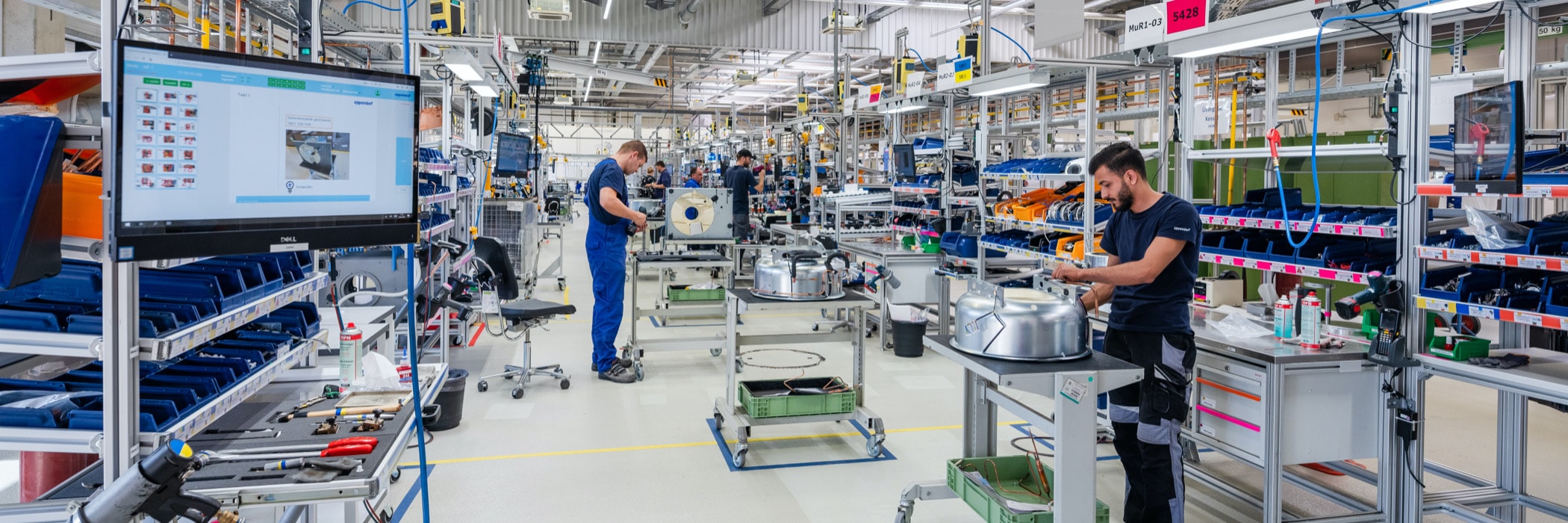
Energy & Emissions
Climate change is one of the biggest challenges of our times. Our business activities generate greenhouse gases. We see it as our duty to help prevent or mitigate climate change for a world worth living in – today and tomorrow. Our goal is to achieve climate neutrality for the Eppendorf Group. To advance toward that aim, we have pledged our support for the goal of the Paris Agreement of limiting global warming to less than 2 degrees Celsius between now and 2100.
The act of manufacturing our products generates CO2 emissions along the entire value chain. We aim to reduce these emissions. Our efforts focus chiefly on CO2 emissions from our own production and administration sites, as well as on CO2 emissions associated with the use of our products by our customers.
Energy-efficient products and technologies are increasingly in demand among our customers. That is why we take energy efficiency into consideration early on in our development processes. From our perspective, investing in climate action and energy efficiency will pay off in the long term, including financially.
Countering risks, meeting requirements
Climate change can bring uncertainty in terms of planning and investment. With an eye to these factors, we are taking action to protect the climate and lower future risks to our business model. For example, increasing the energy efficiency of our processes has the beneficial side effect of lowering our dependence on energy prices, which fluctuate. We also meet the increasingly stringent requirements set by our stakeholders. Our customers in particular – as well as our employees, the owners’ families and legislators – expect us to show strong support for climate action and report transparently on our carbon footprint. Ultimately, our climate action measures will also help implement the principles of the Global Compact.
Developing our climate strategy
Our ambition is clear: to achieve climate neutrality for the Eppendorf Group. This is why we are working on a climate strategy aligned toward the goal set by the Paris Agreement of limiting global warming to less than 2 degrees Celsius between now and 2100. As a first step, we began compiling a carbon footprintcarbon footprintThe carbon footprint describes the total amount of CO2 emissions caused directly and indirectly by an activity, a business or a process. for the entire Eppendorf Group in 2021. We are also collecting data on the CO2 emissions generated by our business activities (Scope 1 and 2), CO2 emissions from transportation and business travel (Scope 3, categories 4, 6, and 9) and emissions arising from the use of our products by our customers (Scope 3, category 11).
As our next step, this initial carbon footprint will serve as the basis from which we plan to derive a Group-wide climate target, which we aim to reach by way of various interim goals. These interim goals will then be set out in a road map of short- to medium-term actions. The focus will be on measures to prevent and reduce emissions. Unavoidable emissions will be offset by suitable mechanisms. To measure our progress, we will assess our carbon footprint annually going forward. The next sustainability report, to be published in 2023, will include information on the progress of our climate strategy.
Meaningful performance indicators
We already capture various performance indicators as part of our environmental management activities, including total energy consumption and energy efficiency in relation to parameters such as area, production output, material input and employee headcount. These performance indicators are captured, analyzed and evaluated annually at the locations that already hold ISO 14001 certification. We monitor the development of these indicators for insight into the impact of our climate action and efficiency measures.
An overview of the reported key performance indicators appears in the section entitled Key Sustainability Indicators.
Efficiency gains: energy audits mark the starting point
Concrete actions to improve energy efficiency can already be identified based on energy audits, which we perform every four years at our most energy-intensive locations in Germany. Since 2015, we have performed two audits at each of our three largest German sites. The results of the audits are analyzed, and our findings are then incorporated into a plan of action that is implemented in stages by the location managers. Implementation is subsequently monitored as part of our Environmental Management Efforts.
Roles & responsibilities
Responsibility for climate action rests with our Chief Financial Officer (CFO), who is in charge of this subject within the Management Board as a whole. The entire Management Board makes strategic decisions and approves specific actions. The development of our climate strategy, carbon footprint tracking and the implementation of all climate actions are handled by the Sustainability & HSE unit. Experts from the specialized departments develop concrete measures and implement them once they are approved.
Relevant standards & guidelines
The Eppendorf environmental and safety mission (HSE Mission) serves as the framework for our environmental actions as a company, and it applies throughout the organization. It stipulates that measures to reduce and prevent environmental impact should be identified, implemented and improved on an ongoing basis. We achieve this goal with our certified environmental activities based on the ISO 14001 standard. Our environmental management system allows us to achieve systematic improvements in our environmental performance, and to manage change processes effectively.
All sites that hold ISO 14001 certificationISO 14001 certificationISO 14001 has been a globally recognized framework for environmental management systems since 1996 and covers essential aspects for continuous improvement of environmental performance. It defines central elements and processes of an operational environmental management system. undergo regular audits in keeping with applicable laws and internal company guidelines. Energy audits are performed every four years; at this time, all Eppendorf locations with ISO 14001 certification have undergone energy audits.
Improving processes, optimizing products
We take a two-pronged approach to climate action. First, we reduce greenhouse gas emissions from our business processes and transportation and travel activities. For example, we purchase electricity from renewable sources and implement energy efficiency improvements. Second, we aim to reduce CO2 emissions during our products’ use phase by taking actions such as developing products with lower impact on the climate. We plan to ramp up company-wide dialogue around climate action. We are currently reviewing which industry initiatives to join with respect to climate action.
Our carbon footprint
In our push to identify our carbon footprint, we began logging, analyzing and evaluating the total energy consumed by our internal business processes (electricity, heating/cooling energy, fuel for our vehicle fleet) in 2021. As an additional factor in our carbon footprint analysis, we also collected information on the CO2 emissions arising from transportation that we commission, as well as business trips taken by plane (Scope 3, categories 4, 6 and 9). We chose 2019 as the base year for our carbon footprint, since the figures for 2020 and 2021 are not representative due to the restrictions brought by the COVID-19 pandemic.
Scope 1scope 1Scope 1 includes emissions that are generated within the company, for example during energy generation from fossil fuels. & Scope 2scope 2Scope 2 refers to emissions from purchased energy such as electricity or district heating. emissions in t CO2
GRI 305-1, -2
(PNG, 50 KB)
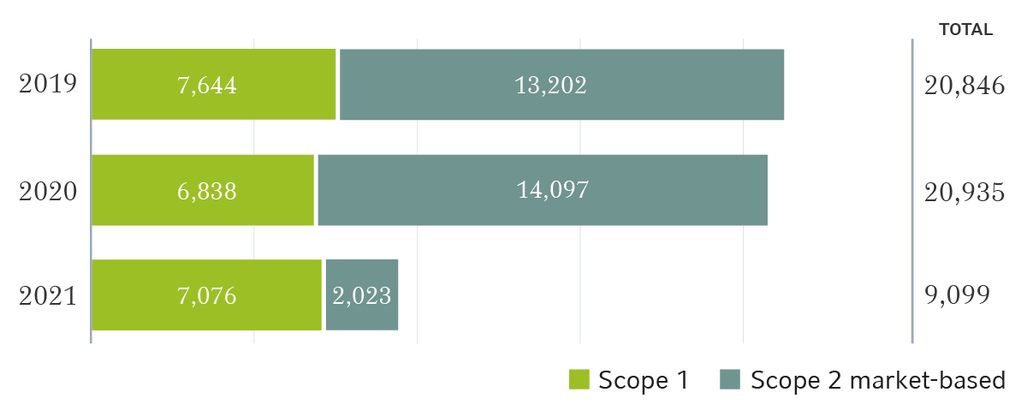
In total, Eppendorf was responsible for 22,731 t of CO2 emissions in 2019. The electricity used at the sites accounted for most of this figure.
Our CO2 emissions from air travel fell in both 2020 and 2021 due to the pandemic. On the other hand, CO2 emissions from air freight rose due to a surge in demand for our products.
CO2 emissions from shipments sent by air from Germany to China came to 531.95 t in 2020. The figure for 2021 was lower, at 395.48 t of CO2 emissions. CO2 emissions from sea freight to Shanghai also declined slightly in 2021. While the figure for CO2 emissions stood at 105.28 t in 2020, it declined in 2021 to 96.21 t. Increased use of rail transportation in 2021 also allowed for considerable savings on CO2 emissions, which came in at 19.62 t.
Moving toward climate neutrality
Sourcing energy from renewables is a core element of our push to reduce emissions. Most of the Eppendorf locations in Germany have been powered by “green” electricity since 2020. The only sites in Germany that were still using conventional electricity at the end of 2021 were our German sales company headquartered in Wesseling and the Eppendorf Distribution Center in Hamburg. Together, these two sites accounted for less than 4% of the total electricity consumed by Eppendorf in Germany in 2021.
By purchasing 38,600,000 kWh of certified “green” electricity, Eppendorf has achieved climate neutrality in terms of calculated electricity use at five sites in Germany for the period from January 1, 2021, until December 31, 2021. This releases up to 16,354 t CO₂ less than would be released if the electricity were generated by energy sources that were part of the average German electricity mixelectricity mixThe term electricity mix refers to the composition of the generated electricity by energy source. In 2021, 46% of the German electricity mix consisted of renewable energies and 54% of conventional energy sources. at the time the certificate was issued.
Locations outside Germany are also powered by renewable energies. Our production site in Enfield, USA, has been operated with 100 % wind energy since 2021.
Eppendorf Group energy consumption in MWh
Download(PNG, 13 KB)
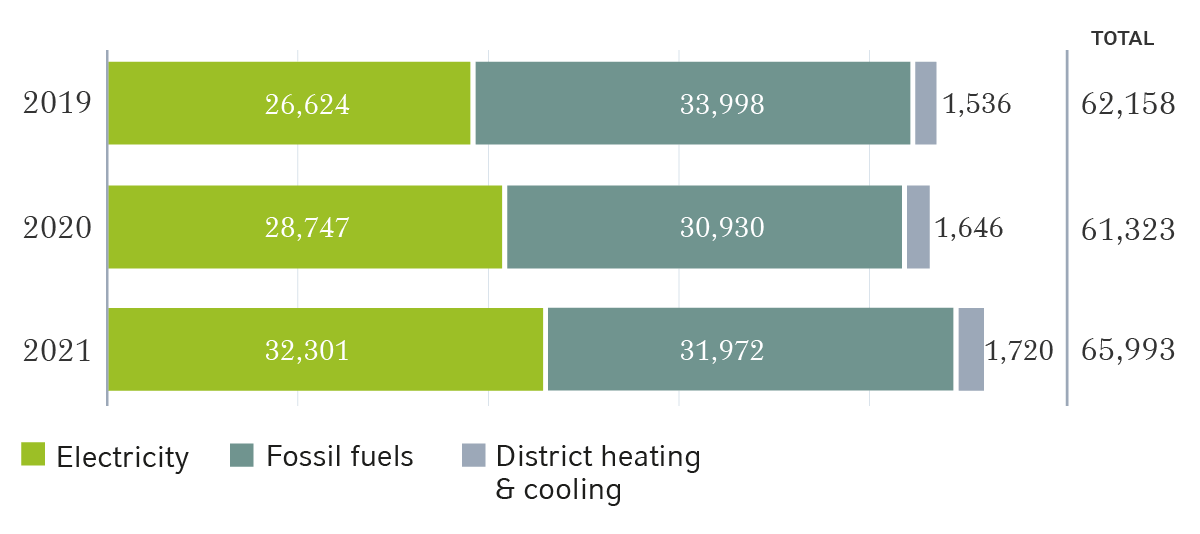
Renewable energies & energy efficiency at our locations
In addition to sourcing our electricity from renewables, we are increasingly generating our own power. In Hamburg, for example, solar panels were installed on the roof of one office building in 2014, supplying energy to power the heat pumps in a geothermal power system.
A new building at the Jülich location is currently being constructed to the Platinum standard of the German Sustainable Building Council (DGNB), the highest standard of sustainable building. The new building will also meet KfW efficiency level 40 Plus, the top efficiency level involving in-house generation and use of electricity.
We are also hard at work in various ways to improve energy efficiency in administration and production. At the Oldenburg site, for example, we commissioned an advanced combined heat and power (CHP) plant back in 2014. The plant supplied 29% of the electricity and 80% of the cooling needed at the plant in 2021. We have also modernized the production facilities at the Oldenburg site, switching to exclusively energy efficient, fully electric injection molding systems and replacing packaging equipment. Additional measures have included optimizing compressors and air conditioning systems, insulating window fronts during renovation activities and forging ahead with the shift to LED lighting.
At our site in Maldon, UK, we reuse the waste heat generated in the process of quality checks of our ultra-low-temperature (ULT) freezers.
Employee mobility
To lower the CO2 emissions generated by our business activities, we also focus on our employees’ mobility, particularly in Germany. Our goal for our fleet of vehicles is to achieve an average of 40 g CO2/km by 2025. The average in 2021 was 101 g CO2/km (2020: 129 g CO2/km). To further reduce our fleet’s CO2 emissions, plans call for procurement of further hybrid and electric vehicles for all sites in Germany. In May 2021, we began shifting all company vehicles at our locations in North America to hybrid options as soon as the leases expire.
We introduced our “JobRad” program for employees at our German locations in 2021. The new program allows employees to lease a bicycle for a 36-month term and make installment payments through deferred compensation. By the end of 2021, 197 company bikes had been purchased under this initiative.
Construction work on a new bike parking building got under way at the Hamburg site in 2021. In all, the building has space for 310 bikes and six bikes with trailers. There is also a sufficient number of charging stations for electric bikes and two service stations equipped with a lift apparatus and air pumps. All this is part of our efforts to support the shift away from cars and make it easier for our employees to choose alternative modes of transportation.
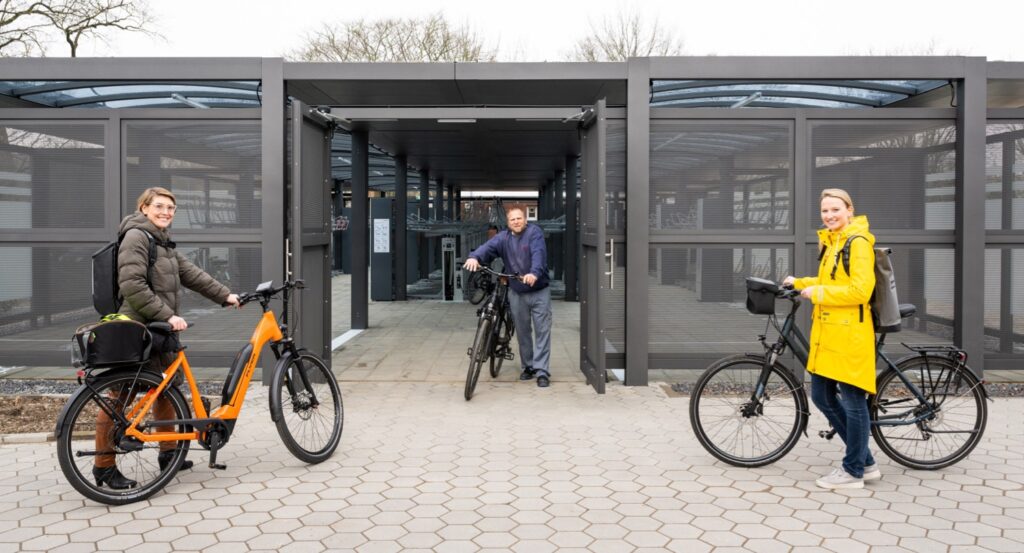
Lowering environmental impact during product development & use
Our climate action efforts are geared toward reducing CO2 emissions during the phase when our products are in use (Scope 3, category 11). Various internal analyses have shown that a considerable portion of our emissions arise during this phase. During the period under review, customers’ use of Eppendorf brand products gave rise to approximately 133,510 t of CO2. We also aim to raise awareness of energy conservation among our customers. The exceptionally high durability of our products is another key factor in reducing their carbon footprint.
Eppendorf has been working with My Green Lab®, an independent nonprofit organization, within the scope of the ACT® Environmental Impact Factor Label since 2017. ACT® certifications satisfy the growing demand among researchers and procurement market companies for transparent information, verified by third parties, on the environmental impact of laboratory equipment. It also takes into account sustainability-related factors such as production, packaging, energy consumption and recyclability. Eppendorf is proud to have its products certified by My Green Lab® as another way to demonstrate that we are pursuing continuous improvement. Multiple Eppendorf products earned certification during the reporting year. The Research plus pipette became the first pipette in the world to earn ACT® certification. Eppendorf 25 mL conical tubes and a further ultra-low-temperature (ULT) freezer (the CryoCube® F570n) also obtained ACT® certification this year. In 2018, the Eppendorf freezers became the first ULT freezers to earn certification under the ACT® label. Eppendorf plans to continue to expand on its cooperation with My Green Lab® and to obtain further certification for Eppendorf products in the future.
Our CryoCube F440n and F570n freezers, launched in 2021, use propane and ethane as natural refrigerants. Both hydrocarbons have very low global warming potential. The previous versions had used substances with much higher potential to contribute to global warming. This is an especially important factor as refrigerants, in the event of improper disposal, can potentially be released into the atmosphere. In the case of the CryoCube F440n, we also increased capacity from 410 L to 440 L even as we lowered the calculated daily energy consumption from 10.8 kWh to 8.3 kWh, resulting in a CO2 reduction of about 0.25 t per unit per year. We also lowered calculated electricity consumption by about 21% for the CryoCube F570n, achieving an average reduction in CO2 emissions of about 0.22 t per unit per year. The calculations are based on European values: 230 V and usage of the European electricity mix.
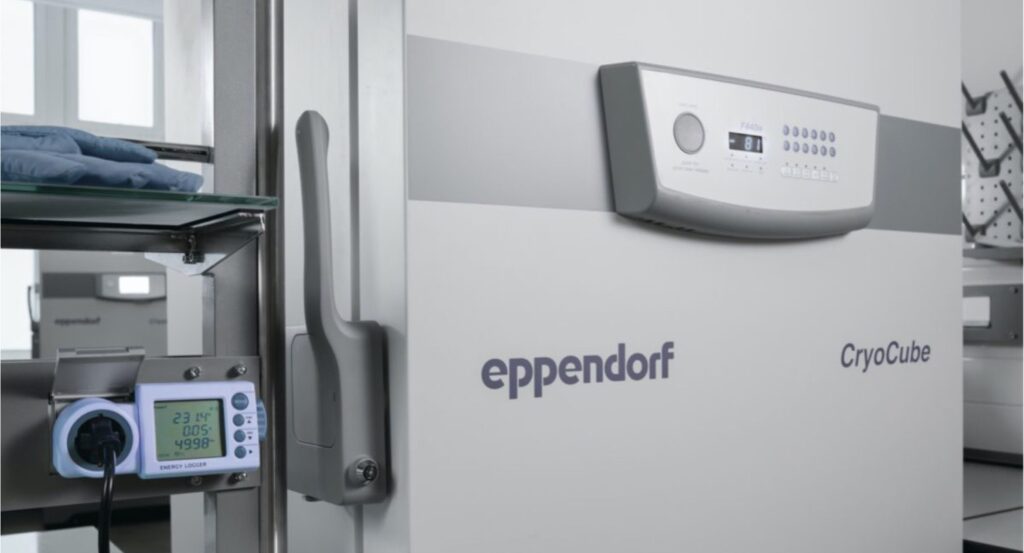
Because ultra-low-temperature (ULT) freezers have to maintain ultra-low temperatures of -80 °C 24 hours a day, even energy-efficient units use large amounts of electricity. The International Institute for Sustainable Laboratories and the nonprofit organization My Green Lab® have joined forces to study ways to optimize the use of ULT freezers from an energy standpoint. To that end, they have launched an annual Freezer Challenge, which Eppendorf is sponsoring as a manufacturer of ULT freezers.
Users of ULT freezers are invited to take action to conserve energy and submit their results to the challenge. Measures to achieve this include efforts such as sharing a unit with colleagues or adjusting the target temperature. Awards are granted annually to the participants who have achieved the greatest energy savings through these actions.
